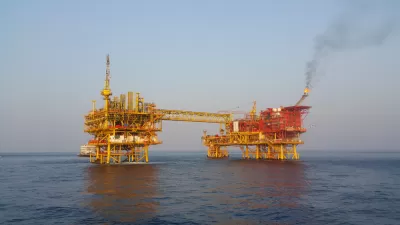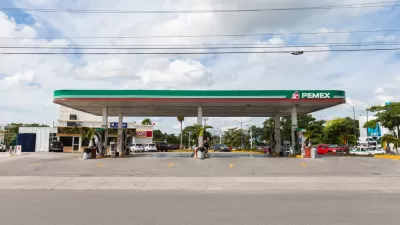Mexico, the world's 9th largest oil producer and first to nationalize its oil production, has seen steep production declines as the state-owned oil company lacks capital resources and expertise. Constitutional reforms would entice private investment.
Clifford Krauss writes that the energy reform laws were proposed by President Enrique Peña Nieto on August 12 for the purpose of attracting investment by international oil companies for "exploration (of) deep-water oil fields in the Gulf of Mexico and large onshore oil and gas shale deposits." The reforms are needed in a nation that now imports half its gasoline from the U.S. as oil production and exports, key to the economic health of the nation, have dropped precipitously in the last decade as we noted here in 2006.
Krauss' colleague, Elisabeth Malkin, wrote a day earlier that the plan, "which would rewrite two constitutional amendments, challenges a bedrock assumption of Mexico’s national identity — its total sovereignty over its energy resources.."
The lack of reinvestment has had dire consequence. She notes that "production has dropped 25 percent from the peak in 2004, to just over 2.5 million barrels of oil a day. In addition, she add that "(d)emand for energy in the country is growing so fast that Mexico could turn from an energy exporter to an energy importer by 2020."
With foreign investment and expertise, "energy experts say the country could increase its production to nearly four million barrels a day by 2024 — potentially vaulting Mexico to the fifth or sixth position among the most prolific oil producing countries", Krauss writes. However, the reforms would have to be strong enough to ensure that "the profit-sharing contracts would be lucrative before (oil companies) invested in Mexico since the country would not formally give the companies a share of the oil reserves."
And that might be a hard sell for the Mexican Congress to support. According to Malkin, "Public opinion is also suspicious about opening up the industry. A survey last year by CIDE, a Mexico City university, found that 65 percent of the public opposed private investment in Pemex, the state-owned oil monopoly.".
Mexico’s left-wing parties have been adamant that the Constitution’s 75-year-old prohibition on private investment should remain ironclad. From the right, the National Action Party, or PAN, proposed energy reform last month that would go even further than Mr. Peña Nieto to invite in private investment.
Neither article delved into the increased use of domestic energy. As we noted here in March about the largest Latin American oil producer, Venezuela, the desire to keep "motorists' happy by having the world's cheapest gas at 18-cents per gallon" resulted in decreased production, exports and increased debt.
According to Bloomberg News, Mexico has "been gradually cutting the subsidy it provides at the gas pump as a way to keep expenses in check and as an environmental measure to remove incentives for wasting gas." In February, the average price of gas was $3.22 per gallon, seven-cents less than in the U.S.
FULL STORY: Oil Reforms by Mexico May Upend Markets

Study: Maui’s Plan to Convert Vacation Rentals to Long-Term Housing Could Cause Nearly $1 Billion Economic Loss
The plan would reduce visitor accommodation by 25,% resulting in 1,900 jobs lost.

North Texas Transit Leaders Tout Benefits of TOD for Growing Region
At a summit focused on transit-oriented development, policymakers discussed how North Texas’ expanded light rail system can serve as a tool for economic growth.

Why Should We Subsidize Public Transportation?
Many public transit agencies face financial stress due to rising costs, declining fare revenue, and declining subsidies. Transit advocates must provide a strong business case for increasing public transit funding.

How to Make US Trains Faster
Changes to boarding platforms and a switch to electric trains could improve U.S. passenger rail service without the added cost of high-speed rail.

Columbia’s Revitalized ‘Loop’ Is a Hub for Local Entrepreneurs
A focus on small businesses is helping a commercial corridor in Columbia, Missouri thrive.

Invasive Insect Threatens Minnesota’s Ash Forests
The Emerald Ash Borer is a rapidly spreading invasive pest threatening Minnesota’s ash trees, and homeowners are encouraged to plant diverse replacement species, avoid moving ash firewood, and monitor for signs of infestation.
Urban Design for Planners 1: Software Tools
This six-course series explores essential urban design concepts using open source software and equips planners with the tools they need to participate fully in the urban design process.
Planning for Universal Design
Learn the tools for implementing Universal Design in planning regulations.
City of Santa Clarita
Ascent Environmental
Institute for Housing and Urban Development Studies (IHS)
City of Grandview
Harvard GSD Executive Education
Toledo-Lucas County Plan Commissions
Salt Lake City
NYU Wagner Graduate School of Public Service




























